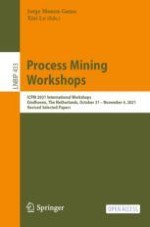This open access book constitutes revised selected papers from the International Workshops held at the Third International Conference on Process Mining, ICPM 2021, which took place in Eindhoven, The Netherlands, during October 31–November 4, 2021.
The conference focuses on the area of process mining research and practice, including theory, algorithmic challenges, and applications. The co-located workshops provided a forum for novel research ideas. The 28 papers included in this volume were carefully reviewed and selected from 65 submissions. They stem from the following workshops:
2nd International Workshop on Event Data and Behavioral Analytics (EDBA)
2nd International Workshop on Leveraging Machine Learning in Process Mining (ML4PM)
2nd International Workshop on Streaming Analytics for Process Mining (SA4PM)
6th International Workshop on Process Querying, Manipulation, and Intelligence (PQMI)
4th International Workshop on Process-Oriented Data Science for Healthcare (PODS4H)
2nd International Workshop on Trust, Privacy, and Security in Process Analytics (TPSA)
One survey paper on the results of the XES 2.0 Workshop is included.
